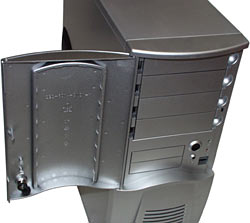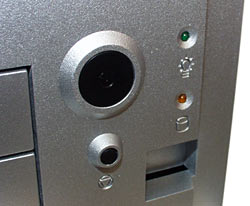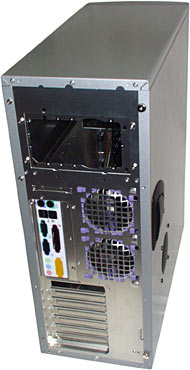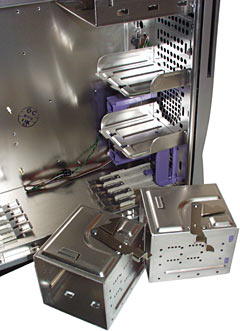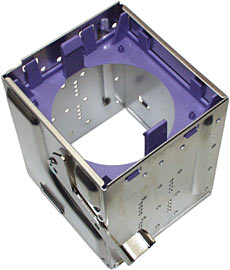
Chieftec Scorpio TX-10WD computer case
Review date: 14 June 2002. Last modified 03-Dec-2011.
If this case looks familiar, there's a reason.
This particular case is called the Chieftec Scorpio TX-10WD. Chieftec have a page about it here. But you may have noticed suspiciously similar cases being sold under quite a lot of other names.
Antec have some products obviously related to this one, for instance. As do Thermaltake; check out this and this. Koolance's current integrated-water-cooling cases bear a strong resemblance to this one, too. And I'm pretty sure Enermax had another entrant in this parade at one point, but they don't seem to be selling it any more.
All of these cases aren't exactly the same, mind you. These aren't just your normal widely-rebadged Taiwanese generic boxes; they come in different shapes and sizes, and in aluminium as well as in steel. The Chieftec case is aluminium, under its powder-coat silver finish. And it's actually rather nice, for the money.
Aus PC Market were selling the TX-10WD for $AU187 without power supply (they don't stock it any more), but that included delivery in the Sydney metropolitan area here in Australia. That's a bit cheaper than the cheapest Lian Lis (these ones). So I had a look at it.
The TX-10WD is a pretty substantial midi-tower, 470mm deep by 205mm wide by 522mm high, but because of its aluminium construction it's lighter than you'd expect. It feels a little flimsier than Lian Li's aluminium cases, but it ought to survive normal treatment with no trouble. Out of the box, everything lines up perfectly well, and you'd have to sit on it with considerable enthusiasm to damage it. It's got swing-out feet on the bottom, too, which make it harder to knock over than the average PC box.
The "D" in the TX-10WD's name indicates that it's got a door, with a weak latch - necessarily weak, so that ejecting drives can pop the door open. There's also a keylock for the door, which if engaged will conclusively stop drives from managing to eject. That's about all it'll stop, mind you; this lock, like most consumer computer gear locks, is rather easier to defeat than the lock on the average eight year old girl's secret diary.
This, fortunately, probably doesn't matter to you, and the rest of the stuff on the front of this case is good. The drive bay covers clip off easily. The four 5.25 inch and two 3.5 inch bays that have front panel holes ought to be sufficient for pretty much everyone's removable storage needs. And the panel does not buzz.
The TX-10WD's finish is pretty good, especially when you remember that this is a sub-$AU200 aluminium case. The front panel's only plastic, but it's perfectly all right looking plastic. And it's not beige. Apparently there exists a beige TX-10WD, but this ain't it.
The back of the TX-10WD shows off a vaguely Lian-Li-ish reversible power supply mounting plate, which allows you to correctly install fancy PSUs with multiple fans, regardless of which way those fans point.
There are also a couple of mounting points for 80mm exhaust fans, but there's nothing mounted there by default.
There are two, and exactly two, thumbscrews retaining the right hand side panel (as you look at the case from the back). The rest of the fasteners are normal hex/Philips head screws, and there are two unused screw holes on the right hand side. But that's OK; the side panel doesn't buzz either.
The side panel has an 80mm fan pre-installed behind a black grille (with simple pegs for mounting, so you can easily reverse it if you want), and a neat lockable clip-handle.
The panel retention method is slightly unusual, but it works fine. To remove the panel, you undo two thumbscrews on the back as usual, then pull on the handle and open the side of the case like a car door. It hinges out somewhat, then comes free. Click it closed again, and it'll stay in place without the thumbscrews if you like, thanks to the handle latch.
The handle lock is about as secure as the front panel lock, of course, but this design is otherwise all good. Because the panel hinges out, the fan that's installed on it doesn't hit anything on the way in or out.
Inside, this case doesn't look totally amazing - the aluminium makes it shinier than usual, but it's still no Lian Li. It does, however, have a few more tricks up its sleeve.
For a start, the four 5.25 inch bays use the snap-in drive mounting method, where you screw special rails onto the sides of the drives, then slide the resulting assembly into place. No need to remove the other side of the case. Nice.
Some rail-mount cases don't give you enough rails for a full complement of drives. Practically all rail-mount cases provide the rails in the bits box, which you may well have lost by the time you want to add another drive. These things are bad. But the TX-10WD does not have either problem.
A full eight rails come with the case, and they sit neatly on little racks at the bottom of the enclosure until they're needed. Unclip however many you need; leave the rest clipped on the rack for later. The only way to lose them is by losing the whole computer, in which case the rails will probably not be your number one concern.
The 3.5 inch bays are neat, too. There are six of them, in two cages of three; you disengage the cages with a simple lever-lock. Again, this means there's no need to take the other side off the case to mount drives.
The two 3.5 inch cages aren't quite the same. The top cage is the one that lines up with the front panel holes; the top two drives in this cage are the ones that can see the outside world, if required.
The bottom cage, however, has another clip-in 80mm fan mount in the front of it. If you want to keep a few hard drives cool, this is the place to put them.
There's a matching grille in the front panel to let the air in. The plastic bezel over the top of the grille will slow things down a bit, but true enthusiasts can knock a hole in it easily enough.
There's yet another clip-in fan mount in the usual place at the bottom of the front panel, too. It is, again, without a fan by default, but if you want lots of ventilation, this case can clearly give it to you. And you won't even need to mess around with screws - just click normal 80mm case fans into place, make sure the front ones are sucking air in and the back ones are blowing it out, and you're done.
Since you get the standard side panel fan as well, this can be a five-fan case without any modifications. Plus however many fans are in your PSU. Aluminium is more thermally conductive than steel, which helps a bit with PC cooling; a bunch of fans helps a lot more, though, and also provides redundancy if one fan's bearings die unexpectedly.
Overall
At this price point, the TX-10WD is a quite impressive piece of gear. But it's up against the Lian Li PC-6 (reviewed here), which is another powder-coat-silver aluminium case, isn't a lot more expensive, has just as many drive bays, and has three fans mounted as standard. Plus, the Lian Li is, well, a Lian Li; the badge may matter to you.
There's no front door or side handle or side fan in the Lian Li, and its drive cages are slightly trickier to remove. But its fit and finish are a little better than the Chieftec case's.
On balance, I'd go for the Lian Li, personally. But there's really not much in it, and the Chieftec case does have genuinely pleasing extra features - not least of which is the front door, which lets you install plain old beige drives and then cover them up.
A stand-out, amazing, world-beating product, the TX-10WD isn't. But it's got no serious flaws, and it's reasonably priced. So it's well worth checking out.
Chieftec's page for the TX-10WD
Buying it
Aus PC Market don't stock the TX-10WD any more, but they've got
plenty of other cases!
(US readers should check out DealTime's case category.)

